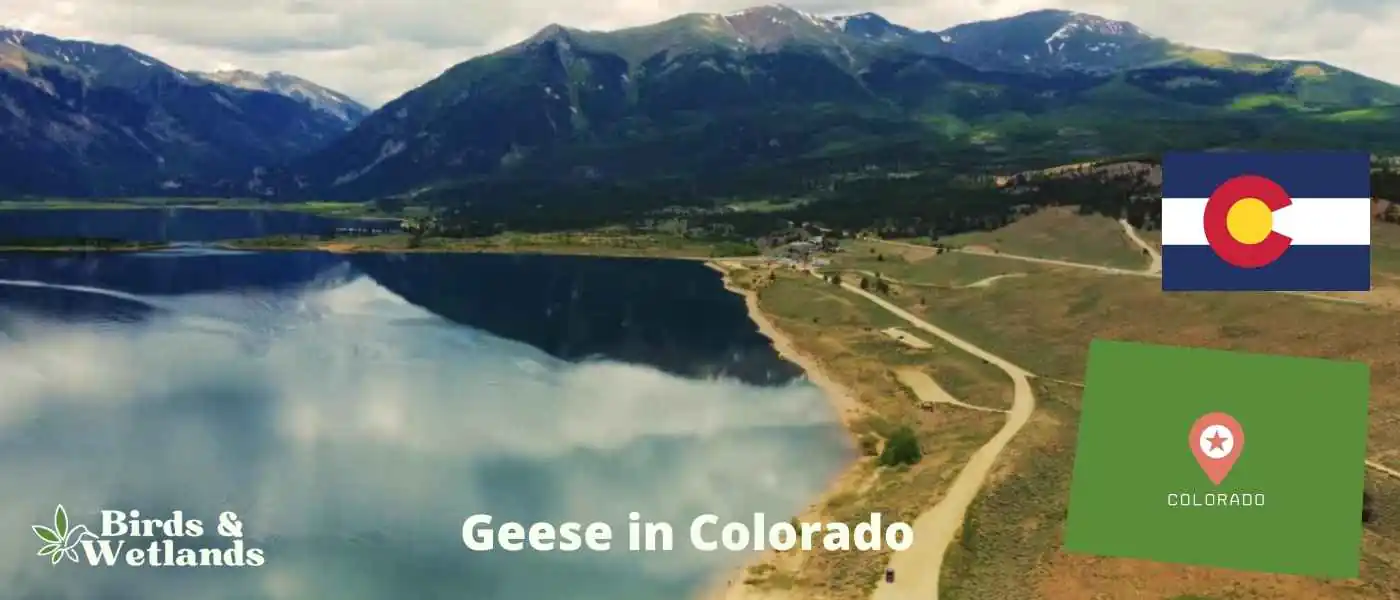Welcome to the captivating world of geese in Colorado! With its diverse landscapes and abundant wetlands, Colorado serves as a haven for various species of geese. From the majestic Rocky Mountains to the serene lakeshores and open plains, the state offers a rich tapestry of habitats that attract these graceful migratory birds.
What Kind of Geese Are in Colorado?
Colorado is the home of 6 goose species and 2 swan species namely:
| Goose | Frequency in Colorado | Resident Population | Specific Locations in Colorado |
|---|---|---|---|
| Canada Goose | Common | Yes | Cherry Creek State Park, Barr Lake State Park |
| Snow Goose | Uncommon | No | San Luis Valley, Lamar area |
| Ross’s Goose | Uncommon | No | Pueblo Reservoir, Chatfield State Park |
| Cackling Goose | Common | No | Walden Ponds Wildlife Habitat, St. Vrain State Park |
| Greater White-fronted Goose | Uncommon | No | Monte Vista National Wildlife Refuge, South Platte River |
| Brant | Uncommon | No | Bear Creek Lake Park, Cherry Creek State Park |
The two swans species present are Tundra Swan and Trumpeter swans.
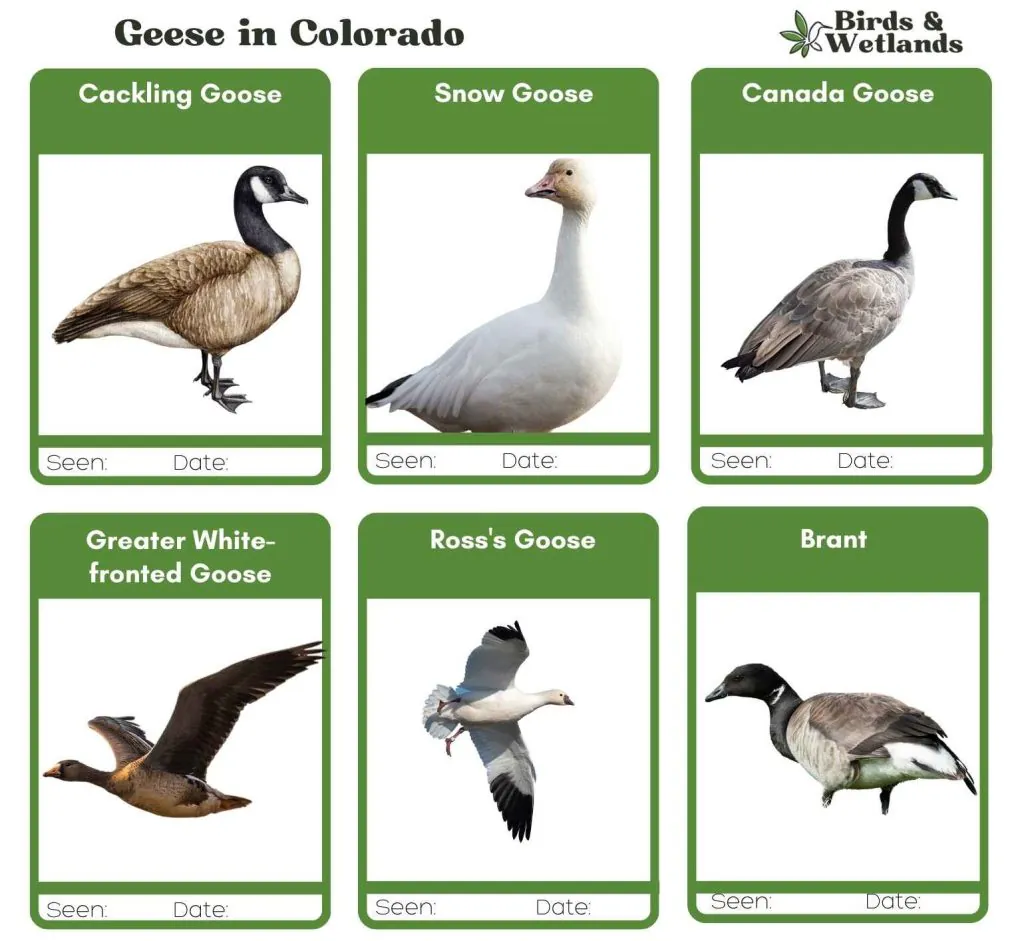
Geese Species Found in Colorado
Canada Goose
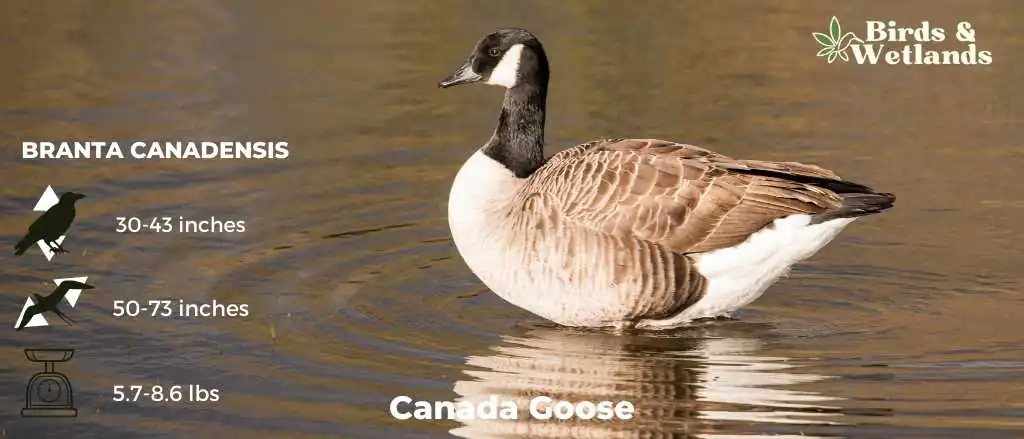
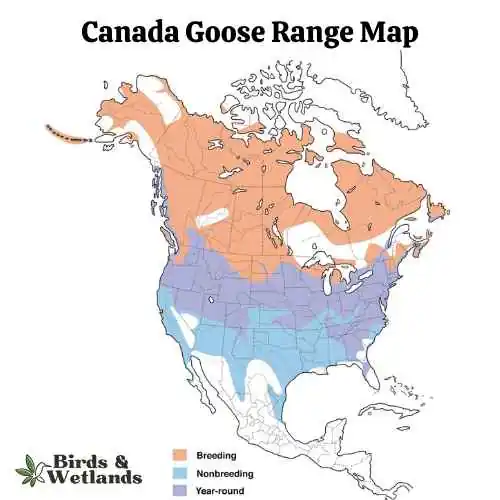
Canada Goose Sound
Scientific Name: Branta canadensis
Length: 30 to 43 in
Wingspan: 50–73 in
Weight: 5.7–14.3 lb
The Canada Goose is a large, well-known species of waterfowl noted for its distinctive appearance, familiar “honk,” and migratory behavior.
Appearance: Both male and female Canada Geese have a similar appearance, featuring a black head and neck with distinctive white patches on the cheeks and chin. The body is primarily brown with a lighter, often white, underbelly.
Diet: Canada Geese primarily feed on plant matter, including grasses, aquatic vegetation, and grains. They can often be seen grazing in parks, lawns, and fields, as well as dabbling in water bodies.
Reproduction: Canada Geese typically nest on the ground near water bodies, often on islands or other isolated areas to avoid predators. The female lays a clutch of about 4 to 6 eggs, which she incubates alone for around a month.
Snow Goose
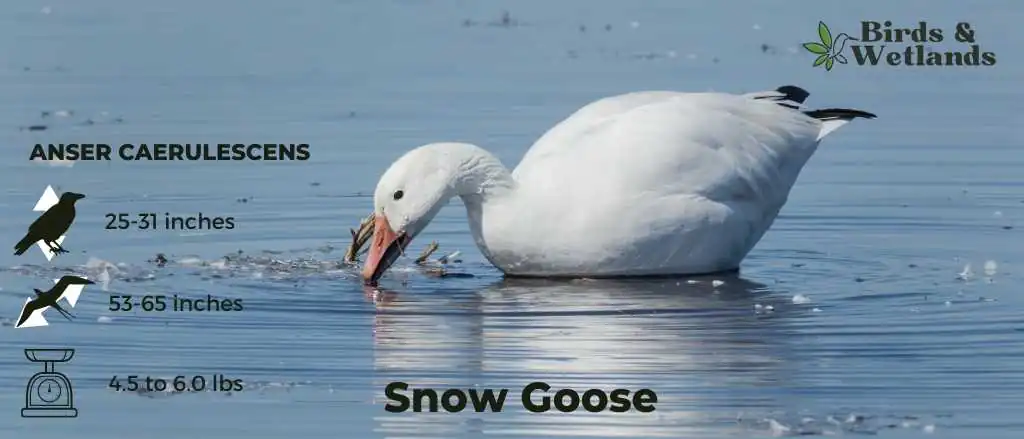
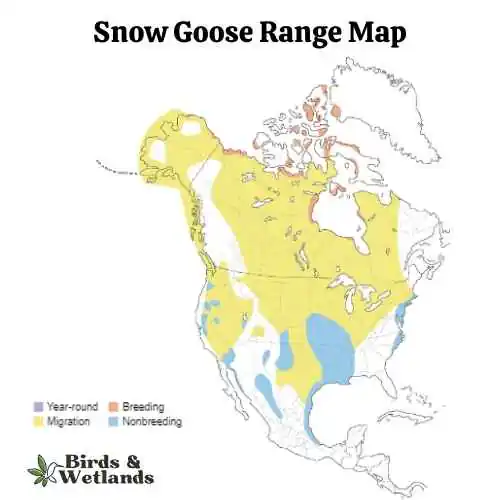
Snow Goose Sound
Scientific Name: Anser caerulescens
Length: 25 to 31 in
Wingspan: 53 to 65 in
Weight: 4.5 to 6.0
The Snow Goose is a large species of waterfowl known for its vibrant white plumage and significant migratory flights.
Appearance: True to their name, Snow Geese are predominantly white with black wingtips. They also have a pink bill, pink legs and feet. A color morph, known as the “Blue Goose,” displays a bluish-gray body with a white head, but is considered the same species.
Diet: Snow Geese primarily feed on plant matter, such as grasses, sedges, and small grains. They can often be seen in large flocks foraging in fields and marshes, and during migration and winter, they can cause considerable damage to agricultural fields due to their feeding habits.
Reproduction: Snow Geese typically nest on the tundra, near water bodies. The female builds the nest and lays a clutch of about 3 to 5 eggs, which she incubates alone for approximately three weeks. Once hatched, the goslings can feed themselves but stay with their parents for protection until they can fly.
Ross’s Goose
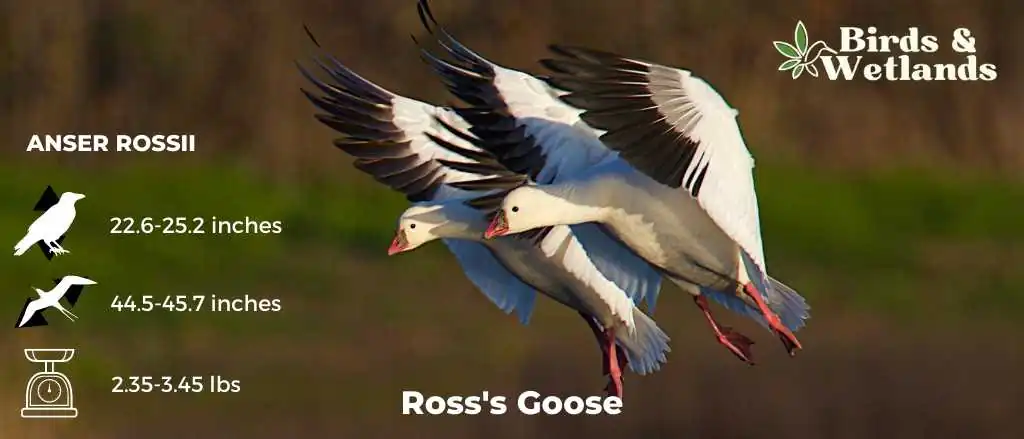
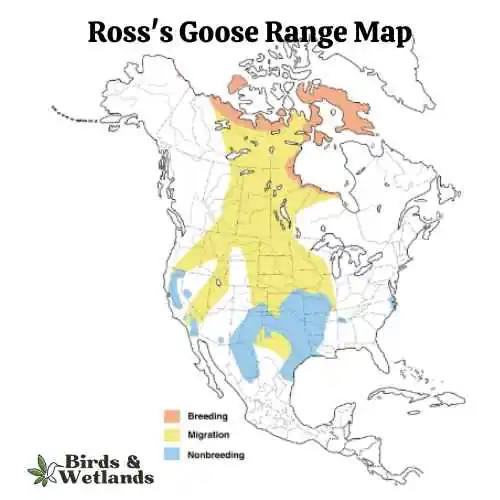
Listen
Scientific Name: Anser rossii
Length: 23.2-25.2
Wingspan: 44.5-45.7 in
Weight:42.3-55.3 oz
The Ross’s Goose is a small species of waterfowl often found in North America’s tundra and wetland habitats.
Appearance: Known for its compact size, the Ross’s Goose is mostly white with black wingtips. It features a short, stubby bill and a rounded head. One key identifying feature is the blueish gray base of its bill, which has a warty structure during the breeding season.
Diet: This goose feeds mainly on vegetation, including seeds, leaves, and roots of grasses and sedges. During winter and migration, they also consume grains and seeds from agricultural fields.
Reproduction: The Ross’s Goose nests on the ground, often in colonies. The female lays a clutch of 2 to 5 eggs which she incubates for around three weeks. The young geese, known as goslings, are precocial – they can walk, swim, and feed themselves shortly after hatching, although they stay with their parents until they learn to fly.
Cackling Goose
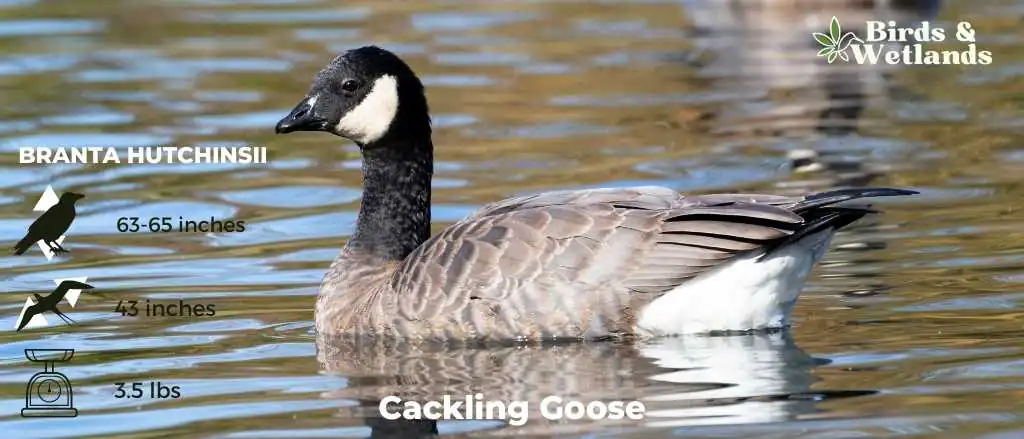
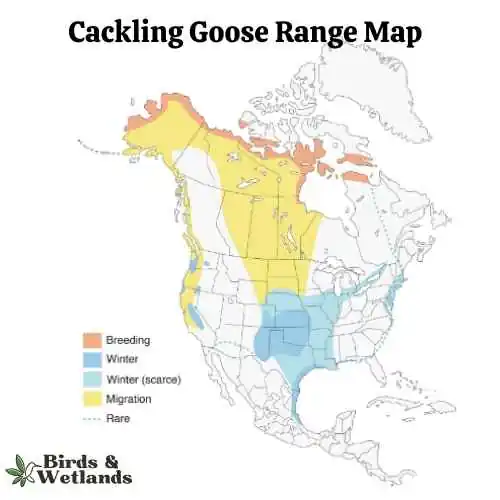
Listen
Scientific Name: Branta hutchinsii
Length: 24.8–25.6 in
Wingspan: 43-45.7 in
Weight:3.5 lbs
Cackling Geese are particularly known for their high-pitched, cackling calls, which is the source of their name. Despite their small size, these geese are renowned long-distance migrants, with some populations traveling thousands of miles between breeding and wintering grounds.
Appearance: With a similar color pattern to the larger Canada Goose, the Cackling Goose features a black head and neck, white chinstrap, light tan to cream chest, and brownish-grey body. One defining characteristic is its noticeably smaller size and stubbier neck compared to its larger counterparts.
Diet: Like many geese, the Cackling Goose’s diet mainly consists of plant matter. This includes grasses, seeds, and aquatic vegetation. They are often seen grazing on land or dabbling in shallow water.
Reproduction: Cackling Geese usually nest on the ground in elevated areas near water bodies, such as riverbanks or lakeshores. The female lays a clutch of 2 to 8 eggs and is responsible for incubation, while the male stands guard nearby. Incubation lasts for about a month.
Greater White-fronted Goose
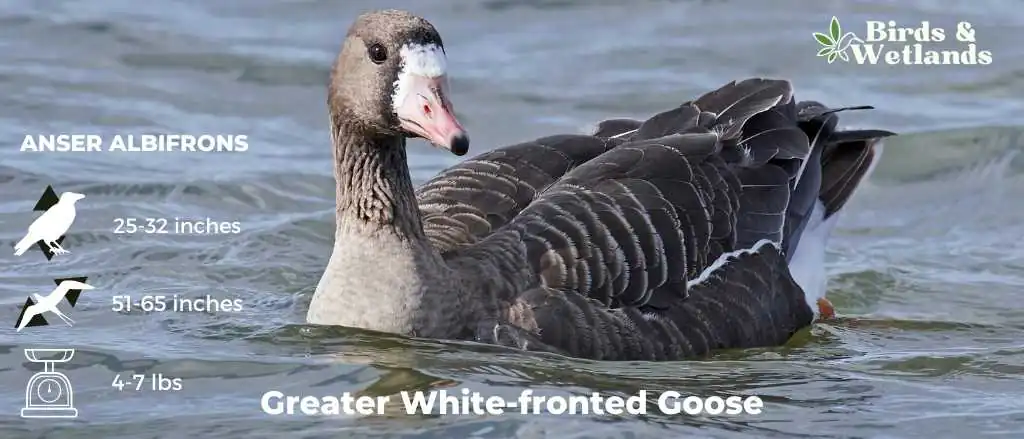
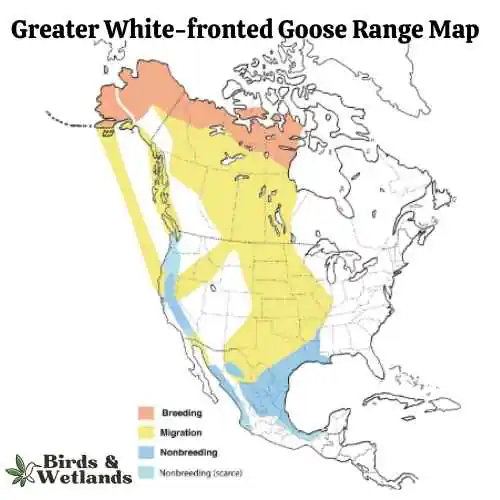
Listen
Scientific Name: Anser albifrons
Length: 25 to 31 in
Wingspan: 53 to 66 in
Weight: 3.3 to 6.6
The Greater White-fronted Goose is a medium to large waterfowl species, widely distributed across the Northern Hemisphere, particularly in North America.
Appearance: As the name suggests, these geese display a prominent white patch at the base of their bill. Their bodies are gray-brown, and their breasts are often marked with dark blotches. They possess a pinkish bill and orange legs and feet.
Diet: The Greater White-fronted Goose is a herbivore and feeds mainly on plant material. Its diet consists of grasses, sedges, grains, and berries. When wintering, these geese can often be found in agricultural fields, feasting on leftover grains and crops.
Reproduction: This species nests on the ground, often in areas with good visibility such as slopes or ridges. The female lays a clutch of 4 to 5 eggs, which she incubates for nearly a month. Once hatched, the young ones are taken care of by both parents until they are able to fly.
Brant
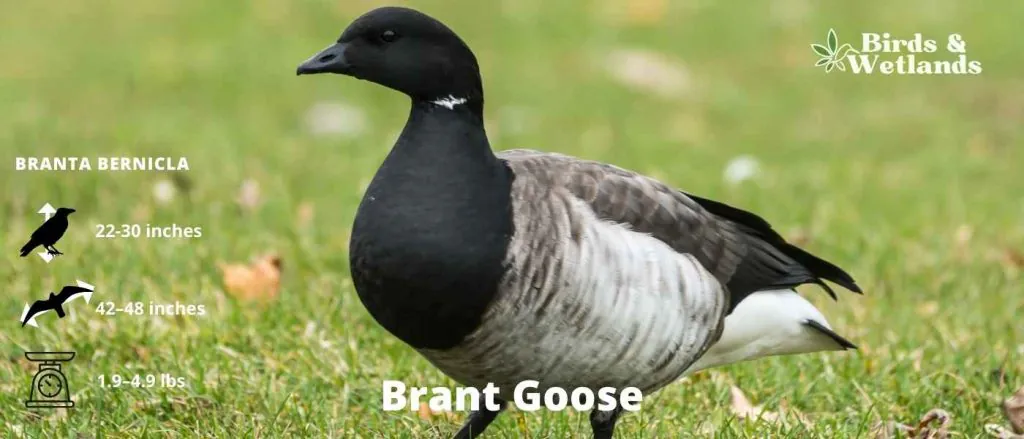
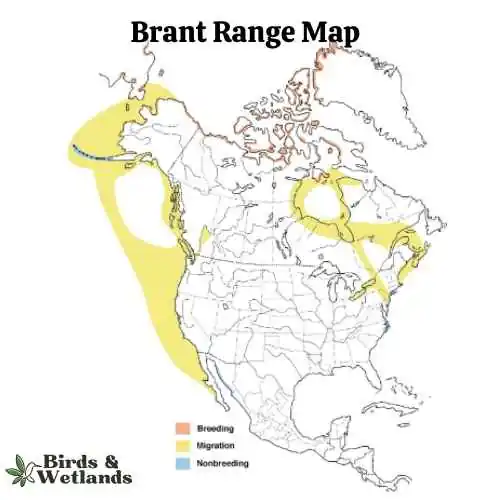
Listen
Scientific Name: Branta bernicla
Length: 22–26 in
Wingspan: 42–48 in
Weight: 1.9–4.9 lb
The Brant is a compact species of goose that is known for its striking appearance and interesting migratory patterns.
Appearance: The Brant is recognized for its dark, sooty color with a white crescent on the neck. The body is mostly black to dark gray, contrasting with the lighter underparts. Its small size, as compared to other geese, and short, stubby bill are other distinct features.
Diet: The Brant’s diet primarily consists of aquatic plants, especially eelgrass and sea lettuce. During the breeding season, they may also feed on grasses, sedges, and insects.
Reproduction: Brants typically breed in the high Arctic tundra. The female lays a clutch of 3 to 5 eggs in a ground nest, which she incubates for about a month.
Notably, Brants make an impressive long-distance migration every year. They spend their winters along both the east and west coasts of the United States and travel to the Arctic regions of Canada, Alaska, and even Russia to breed.
Where to Spot Colorado’s Geese
Barr Lake State Park: Located in Brighton, Colorado, Barr Lake State Park is a popular spot for birdwatching, including geese.
Cherry Creek State Park: Situated in Aurora, Colorado, Cherry Creek State Park offers excellent opportunities for birdwatching and spotting geese.
Rocky Mountain Arsenal National Wildlife Refuge: Located near Denver, Colorado, the Rocky Mountain Arsenal National Wildlife Refuge provides a sanctuary for wildlife, including geese.
San Luis Valley: Situated in southern Colorado, the San Luis Valley is an important stopover for migrating geese. The valley’s wetlands and agricultural fields provide ample food and resting grounds for these migrating birds.
South Platte River: The South Platte River, flowing through multiple areas in Colorado, serves as a vital corridor for waterfowl, including geese.
| Neighboring State | Best Spots to See Geese |
|---|---|
| Wyoming Geese | 1. Seedskadee National Wildlife Refuge 2. Yellowstone National Park 3. Jackson Hole |
| Nebraska Geese | 1. Rowe Sanctuary 2. Lake McConaughy 3. Crescent Lake National Wildlife Refuge |
| Kansas Geese | 1. Quivira National Wildlife Refuge 2. Cheyenne Bottoms Wildlife Area 3. Milford Reservoir |
| Oklahoma Geese | 1. Salt Plains National Wildlife Refuge 2. Wichita Mountains Wildlife Refuge 3. Great Salt Plains Lake |
Are There Any Resident Colorado Geese?
Yes, there are several resident flocks of geese in the Centennial state. The most common variety is the Canada Goose, which can be found in many Colorado parks and open spaces throughout the state.
These geese are year-round residents (mainly due to climate change), and they often form large flocks (literally hundreds of thousands) that can be quite noisy, you may need to use some deterents (even more than one method including visual barriers and noise – see our guide to sounds that scare geese) to discourage geese from your land or urban areas.
Remember it is illegal to kill Canada geese, unless permitted under Canada Geese Protection Colorado. Instead use one of the methods we suggest to deter geese and stay persistent in trying to deter them, from gardens, golf courses and Denver parks.
Hunting Geese in Colorado
In Colorado, it is legal to hunt geese with a small-game license, as long as you have the correct permits allowed by the wildlife service.
The state offers several different types of licenses, so be sure to purchase the one that covers waterfowl hunting and ensure you are in the hunting season and stick to the bag limits.
Can You Hunt Geese in Colorado?
Colorado is known for its abundance of wildlife, and birdwatching is a popular pastime in the state.
However, some residents take a more active role in managing the state’s bird population, and hunting is permitted in certain areas, as geese have no natural predators there is an overabundance of them.
Colorado has a daily bag of three (3) dark geese and a possession limit of six (6) dark geese. You can read the full daily bag and possession limits of Colorado here.
Where Is the Best Place to Hunt Geese in Colorado?
If you’re looking for a great place to hunt geese in Colorado, the South Platte River is a good bet. This river flows through northeastern Colorado, and it’s a popular spot for migrating birds.
The South Platte River is also home to a variety of other wildlife, so you’re sure to see plenty of other animals while you’re out hunting.
Is There a Goose Hunting Season in Colorado?
Depending on the goose species, the goose hunting season in Colorado starts in October and ends in April. Here is the full list of goose hunting seasons in Colorado.

